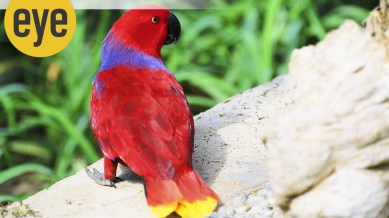Why birds look the way they do: Decoding Mother Nature’s Logic
In the painted snipe, a water bird, the lady sports snazzy white straps and kathakali dancer-like face make-up. Her husband looks similar but as though he’s been given a good rubbing down with a pencil eraser

Usually, there is a lot of logic in how Mother Nature goes about evolution but sometimes, she leaves you scratching your head… Take birds, for example. Now, around 10,000 species of them, most dressed so they can easily identify each other. Even better gentlemen can identify their ladies, so there can be no misfortunate mix-ups within species.
Now most bird species are monogamous – taking on one partner (for at least one season) and these may be very similarly clad. Yes, gentleman sparrows strut around showing off their black bibs – which the girls lack but others like larks, crows and pigeons are quite similar, sometimes with differences which only the couple can tell apart. This, the reasoning goes, is because both parents need to feed their chicks – their families have many ravenous mouths. And their plumage is usually somewhat ‘cryptic’ to keep them hidden in their nests or holes from predators. All very good, but, there are so many species where the gentlemen do not look after their families (and have plenty of babies to boot), and I love to think, that because of this lackadaisical, irresponsible attitude on part of their husband, the lady insists that he dress in the most absolutely and absurdly colourful (and usually beautiful) glad rags ever, if he wants her to get interested in him! Hence, we have the peacock, the fabulous pheasants and the birds of paradise. Not only that, she may insist that he build grand palaces for her and dance. But he remains a cad and will run after as many ladies as he can, disseminating his genes as far and wide as he can. The gentleman weaver, in fact, will woo as many ladies as he can by building as many magnificent edifices as he can manage.
As for raptors, as in eagles, usually, the lady is much larger and more powerful than her husband. It’s hard to imagine why this should be, considering he does most of the hunting (though many do hunt together) and she, the delicate feeding of the brood. One reason touted is that the husband may become so enthused by all the killing that (like so many males) he may not stop at the prey and include his own progeny, though this is hard to believe. The other is, that over time the residences of these birds (to which they return every season) become so big that a huge male would simply crash into them while approaching with a meal. In any case, his meal is quickly snatched by his waiting wife, who then breaks it up into tiny slivers to feed her family with a delicacy and tenderness that is astonishing. Now, as we’ve seen above, where the gents and ladies are clad differently, it’s usually the far less flamboyant lady that is in charge of feeding the family while her husband does the philandering.
But there are families of birds (just 10 percent), where something spectacular happens, and again you wonder the logic of it all: In the painted snipe, for example, a water bird lurking around the edges of marshes and sedges, it is the lady that is gorgeously clad, in wine red and olive green, sporting snazzy white straps and kathakali dancer-like face make-up. Her husband looks similar but as though he’s been given a good rubbing down with a pencil eraser. What’s more, the lady wears the pants: she lays her eggs, and sits her husband on them, ordering him to hatch them while she goes looking around for new dudes. The logic here again, is that this way she can disperse as many of her genes via her eggs) as possible, which is good for the species. Not only this, the ladies whack each other solidly, to win their etiolated husbands! Exactly the same reason that was touted for Messer Peacock and company! Purple swamp-hens and pheasant-tailed jacanas are among these too where the ladies do battle with each other, though here both sexes are more or less identically dressed. Go figure!
When many of these sexually dimorphic birds were first discovered, they were thought to be different species altogether, until the time they were caught in what we like to call ‘compromising positions’! Now the rule of thumb became: gentleman bright and gaudy, lady drab and dull. But when it came to the Eclectus Parrot of the Solomon Islands, it was found that the lady was a gorgeous stunning scarlet and indigo blue, and the gent a deep emerald green (camouflage colours again!) and for decades scientists thought they belonged to a different species. And here’s the killer googly: The scarlet lady broods and brings up the young, her emerald husband forages – the opposite of what is meant to happen as in the painted snipe! Apparently their nesting holes are so deep, that she remains hidden – and safe. No need for drab camouflage!